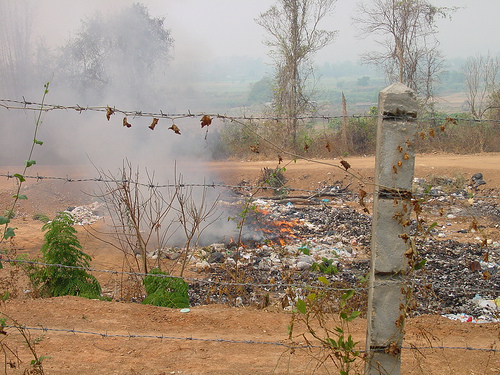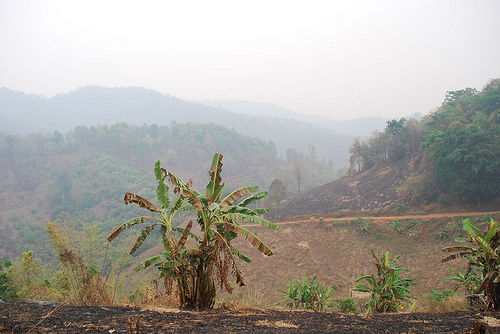On location in Thailand
A common comment on the weather in Thailand is that there are two seasons - wet and dry. Lately though there has been a third season gaining prominence: the burning season. As farmers prepare their field for the growing season, many do so by setting their fields ablaze. There is also a substantial amount of forest land that is burnt for new farm fields. This is not only bad for the world renowned forests of northern Thailand, but also for breathing people everywhere.
With the specifics of northern Thailand geography, the smoke tends to hang in the air, choking farmers and residents of nearby cities, like Chang Mai. Some governments have even issued warnings urging tourists to avoid these areas during prime burning time in the spring. When the particulates eventually move, it effects the larger cities to the south, such as Bangkok, where most of Thailand's population lives. We are currently in the southeast along the coast and with the winds coming from the north some days smell like a campfire.
Reasons for field burning

There are many possible reasons for the burning: outdated farming techniques, lack of education regarding the effects on the land, air, and people, poor enforcement of protected areas, and so on. In Thailand there is much debate as to the primary driver of these practices, who is responsible for correcting them, and as a result who should shoulder the blame for their consequences. (See a broad based campaign here.) There are even those that will deflect the responsibility away from Thailand claiming more of the burning is done in neighboring Laos or Myanmar. But a recent study published in the Bangkok Post claims that farmers are burning forest land to farm corn for ethanol or other mono-crops that are being pushed by large agribusiness. These two themes (the evils of government subsidies and big-business) may be nothing more than convenient scapegoats as there is plenty of evidence of farmers burning fields as a regular practice to remove the remains of the previous season's crop when traditional crops are planted.
Struggle between food and fuel
This is part of Thailand's version of the worldwide energy/food debate as food and energy compete for land and water resources that are being stretched farther and farther. The specifics may change, but the core factors remain the same. In the developed world the complaint is that the price of a steak goes up as the underlying feed cost increases. While in regions of the world where food costs gobble up a higher proportion of income, the object of debate is lower on the food chain, in the form of grain or oil used for basic cooking. This is a significant concern for governments that control the price of basic needs through subsidies or price controls.

The price of basic foods can be a main contributor to inflation. In some developing countries such as Thailand and China, the figure can reach 3% and 4% respectively, or as high as 9% in India. Food prices are the source of many demonstrations, as consumers feel they are being gouged and suppliers feel they are being shorted.
The strength of these pressures can be seen in recent government policy changes. In March 2011, Energy Ministry of Thailand, the world's third largest producer of palm oil, diverted 5,000 tons of palm oil earmarked for biofuel production to be refined into cooking oil instead. 10,000 tons of privately held were likewise diverted for cooking oil production and an additional 30,000 tons were imported for domestic consumption.
In October 2011 Thailand's mandate for biodiesel blends increased from 4% to 5% (percent of renewable stock in diesel). The continuation of this mandate is to be determined by stocks at the beginning of 2012. Similar moves were made in other palm oil producing nations such as Malaysia and Indonesia, conflicting long term plans to increase biofuel production and short term moves to shore up local food supplies. As demand for what used to be basic commodities pushes up prices, inching them closer to cash crops, the once simple decision-making paradigms shift--and often at the expense of the environment or those least able to adapt to the change.
Any viable long-term energy solution will have to work within a web of cascading consequences; the most tangible may be how typical residents of the planet will feed themselves.



Comments
Robert, great to hear from you again on ChEnected. Always in an interesting place.. This problem of the burning is so hard to read about, especially knowing that it will become more pervasive as the population increases.
Thanks, good to be back! It is hard to see these hard working people (and many like them in developing countries) not only squeezed by increasing costs but also by conflicting priorities of the powers that be. It makes these hard problems even more challenging seeing there are plenty of unintended consequences. But I still think there are viable alternatives, but working the problem all the way through the chain is key for complete success.
Look for piece about Gasfrac, which uses gelled propane to take the water out of fracking. Could help in areas like south Texas.
Hi Robert, thanks for the thoughtful article! I appreciate your recognition and explanation of some of the deeply rooted interactions between food and fuel. This all becomes increasingly complicated when we consider that fields aren't the only entities subject to burning, but that household waste is also burned along with forests, meaning plastics and other household materials are burned too. As most things with such broad social and environmental implications go, there seems to be a huge question as to what motivates people to burn. If it were more obvious that burning fields could lead to increased availability of farmland, that might at least provide a hint as to how to approach the problem, but it doesn't seem to be the only reason. I wonder what the density of these areas is, and how community awareness to the consequences of these actions is promoted. My hunch is that there isn't a sustainability plan in place for these towns (wishful thinking!) -- but wouldn't it be great to see what kind of an impact such a plan would have? From personal experience, my assumed home town of Naples, Italy, has built an unfortunate reputation regarding poor waste collection and management, and waste burning. These problems are mired in organized crime tactics and politics, but easier to assess as a result (since the source of the problem is somewhat evident). The burn problem in Northern Thailand is a real mystery and curiosity to me.
The areas in Thailand where the field burning is most prevalent are low density rural populations. The education of these populations is a major hurdle. Many are simply following the same practices their ancestors did. There needs to be more educational outreach regarding better farming practices and how these activities affect nearby populations (which in the past were not so near). Even harder is to get them to understand and reap long-term benefits of alternative practices. Soon after the article that prompted this post, I saw one about a village in the north that was actively preserving their forestland. They were using it as a tourist attraction and tracking the economic benefits of keeping the forest to attract business. It is difficult to put a tangible value on forest and undisturbed nature, hopefully this will provide a case study for better practices here. On the burning waste - I would say that here in rural areas that burning waste (of any kind) is the primary practice. One reason is that in non-urban areas there is no choice - there are no services like trash pickup. There is also a historic reason, common to most of the developing world and definitely Asia. These countries have advanced technologically in as little as a generation. This includes a move from biodegradable packaging (leaves, cotton, canvas, etc) to the omnipresent plastic bag. These places have a huge littering problem (and in the rare case it is collected - a burning problem) because very they are used to throwing packaging on the ground without a problem. Before, crack open a coconut, drink the water, and chuck it to the ground - now the plastic bottle that water comes in will last nearly forever. I have found this to be true in areas that I have been such as China, Thailand, and India. If anyone is looking for an in depth look at the plastic problem that is rapidly developing in our oceans because of habits like this, read Moby Duck. Written from a non-technical perspective following the global circulation of goods and commerce (mainly plastics) with excellent research (that winds up getting a little technical).